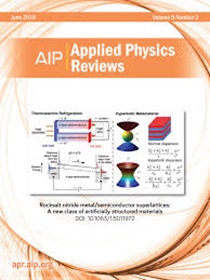Printing semiconductor-based devices and circuits for flexible electronic skin
IF 11.9
1区 物理与天体物理
Q1 PHYSICS, APPLIED
引用次数: 0
Abstract
Electronic skin (e-skin), capable of sensing a physical or chemical stimulus and triggering a suitable response, is critical in applications such as healthcare, wearables, robotics, and more. With a substantial number and types of sensors over a large area, the low-cost fabrication is desirable for e-skin. In this regard, printing electronics attract the attention as it allow efficient use of materials, “maskless” fabrication, and low-temperature deposition. Additionally, the use of e-skin in real-time applications calls for faster computation and communication. However, due to limitations of widely used materials (e.g., low mobility) and the printing tools (e.g., poor print resolution), the use of printed electronics has been restricted to passive devices for low-end applications until recent years. Such limitations are now being addressed through high-mobility materials and highlighted in this review article, using e-skin as a vehicle. This paper discusses techniques that allow printing of high-quality electronic layers using inorganic nanostructures, and their further processing to obtain sensors, energy harvesters, and transistors. Specifically, the contact printing, transfer printing, and direct roll printing are discussed along with working mechanisms and the influence of print dynamics. For the sake of completeness, a few examples of organic semiconductor-based devices are also included. E-skin presents a good case for 3D integration of flexible electronics, and therefore, the use of high-resolution printing to connect various devices on a substrate or 3D stack is also discussed. Finally, major challenges hindering the scalability of printing methods and their commercial uptake are discussed along with potential solutions.为柔性电子皮肤印刷基于半导体的器件和电路
电子皮肤(e-skin)能够感知物理或化学刺激并触发适当的响应,在医疗保健、可穿戴设备、机器人等应用中至关重要。在一个大的面积上有大量的传感器和类型,低成本的制造是电子皮肤的理想选择。在这方面,印刷电子学由于能够有效地利用材料、“无掩模”制造和低温沉积而引起人们的注意。此外,在实时应用中使用电子皮肤需要更快的计算和通信。然而,由于广泛使用的材料(例如,低流动性)和印刷工具(例如,低打印分辨率)的限制,直到最近几年,印刷电子的使用一直局限于低端应用的无源器件。这些限制现在正在通过高迁移率材料得到解决,并在这篇综述文章中强调,使用电子皮肤作为载体。本文讨论了使用无机纳米结构打印高质量电子层的技术,以及它们的进一步加工以获得传感器、能量收集器和晶体管。具体讨论了接触印刷、转移印刷和直接卷印印刷的工作机理和印刷动力学的影响。为了完整起见,还包括一些基于有机半导体的器件的例子。电子皮肤为柔性电子的3D集成提供了一个很好的案例,因此,还讨论了使用高分辨率打印来连接基板或3D堆栈上的各种设备。最后,讨论了阻碍印刷方法可扩展性及其商业应用的主要挑战以及潜在的解决方案。
本文章由计算机程序翻译,如有差异,请以英文原文为准。
求助全文
约1分钟内获得全文
求助全文
来源期刊

Applied physics reviews
PHYSICS, APPLIED-
CiteScore
22.50
自引率
2.00%
发文量
113
审稿时长
2 months
期刊介绍:
Applied Physics Reviews (APR) is a journal featuring articles on critical topics in experimental or theoretical research in applied physics and applications of physics to other scientific and engineering branches. The publication includes two main types of articles:
Original Research: These articles report on high-quality, novel research studies that are of significant interest to the applied physics community.
Reviews: Review articles in APR can either be authoritative and comprehensive assessments of established areas of applied physics or short, timely reviews of recent advances in established fields or emerging areas of applied physics.
 求助内容:
求助内容: 应助结果提醒方式:
应助结果提醒方式:


